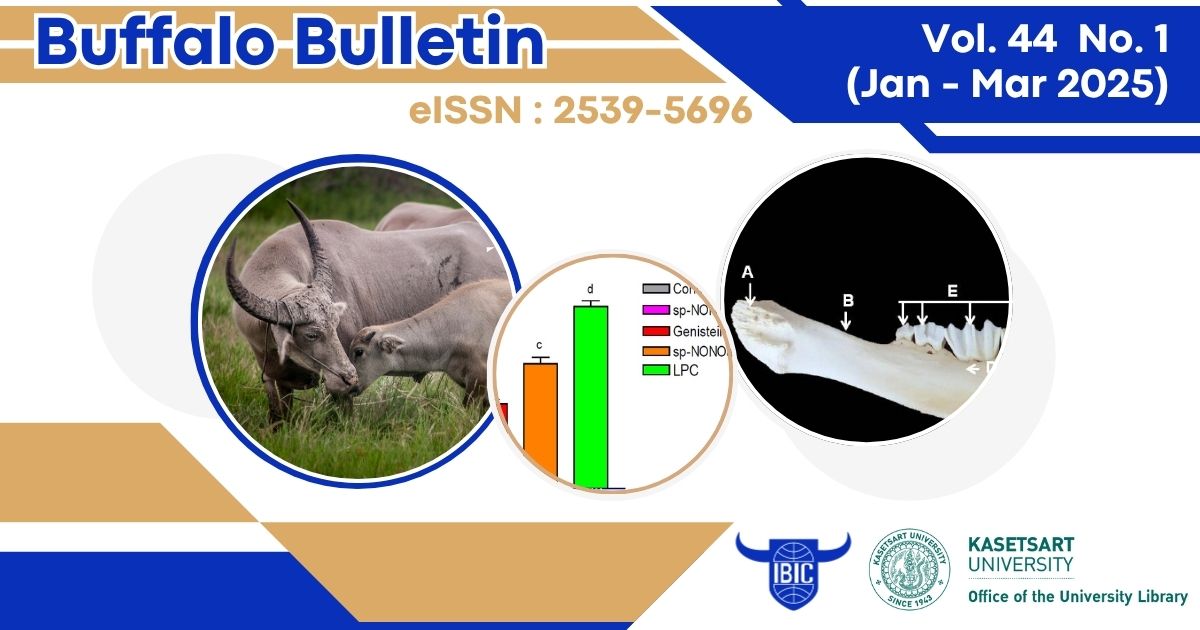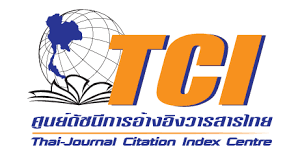NON-GENETIC FACTORS AFFECTING THE FIRST LACTATION PRODUCTION EFFICIENCY TRAITS IN BUFFALOES-A REVIEW
DOI:
https://doi.org/10.56825/bufbu.2025.4414582Keywords:
Bubalus bubalis, buffaloes, production efficiency traits, persistency, non-genetic factors, first lactation yieldAbstract
Buffalo has been an integral part of livestock agriculture in Asia over 5,000 years producing milk, meat, draft power and hides. Buffalo is important for draft power and provides up to 30% for agricultural operations. The world population of buffaloes has undergone demographic changes over a period of time in different tropical countries. Due to geographical location and domestic need, riverine buffaloes acquired preponderance over swamp buffaloes across various agro-climatic regions of the country. Buffalo, by and large, remained neglected as compared to cattle by national and international agencies despite its economic status. Approximately, 80% of Indian buffaloes are non-descriptive while the remaining belongs to eight classified breeds. The dairy industry is dependent to a greater extent on level of production and reproduction performance of the animals in India. There are many non-genetic factors like period of calving, season of calving, age of dam etc., which influence the phenotypic expression of production and reproduction traits. Production and reproduction traits are antagonistic to each others. There are many production efficiency traits like Milk yield per day of lactation length (MY/FLL), Persistency (P), milk yield per day of calving interval (MCI) and milk yield per day of age at second calving (MSC) might be thought of as combinations of production and reproduction traits and can be used as selection tool. The productive efficiency performances of buffaloes are determined by milk yield and different reproduction traits. Therefore, production efficiency traits which are based on both production and reproduction traits are the best criteria for the selection and overall improvement.
Downloads
Metrics
References
Bhalaru, S.S. and J.S. Dhillon. 1981. First lactation milk yield versus some measures of efficiency of milk production as the selection criterion for buffaloes. Indian J. Anim. Sci., 51(2): 153-156.
Bharat, N.K., P.C. Thapan and G.C. Gohlot. 2004. Production and reproduction performance of light breed of buffaloes. Indian J. Anim. Sci., 74(5): 527-529.
Bhat, P.N. and R. Kumar. 1979. Effect of genetic and non-genetic factors on persistency of lactation in Indian buffaloes. Indian J. Anim. Sci., 49: 875-878.
Chakraborty, D. 2008. Genetic studies on production efficiency attributes in Murrah buffaloes. M.VSc. Thesis, Chaudhary Charan Singh Haryana Agricultural University, Hisar, India.
Chakraborty, D. and S.S. Dhaka. 2020. Sire evaluation based on first lactation production efficiency traits in Murrah buffaloes. Journal of Buffalo Science, 9: 71-75. DOI: 10.6000/1927-520X.2020.09.09
Chakraborty, D., S.S. Dhaka, B.L. Pander and A.S. Yadav. 2010. Genetic studies on production efficiency traits in Murrah buffaloes. Indian J. Anim. Sci., 80(9): 898-901.
Dev, K., S.S. Dhaka, A.S. Yadav and S.K. Sangwan. 2015. Genetic parameters of early performance traits in Murrah buffalo. Haryana Veterinarian, 54(2): 144-146. Available on: https://www.luvas.edu.in/haryana-veterinarian/download/harvet2015-2/14.pdf
Dhar, M.Y. and K.S. Deshpande. 1995. Factors affecting production efficiency in Murrah buffaloes. Indian J. Dairy Sci., 48: 40-42.
Dutt, T., B. Bhushan and S. Kumar. 2001. First lactation and life time performance traits in Murrah buffaloes. Indian J. Anim. Sci., 71(5): 483-484.
FAOSTAT. 2018. http://www.fao.org/faostat/en/#data
Godara, A. 2003. Genetic studies on performance traits in different lactation of Murrah buffaloes. M.Sc. Thesis, Chaudhary Charan Singh Haryana Agricultural University, Hisar, India.
Kandasamy, N., V. Ulaganathan and A.R. Krishnan. 1991. Genetic analysis of milk yield per day of second calving of Murrah buffaloes. Indian J. Dairy Sci., 44: 519-521.
Kumar, A. 2008. Genetic studies of production efficiency traits and evaluation of surti bulls on the basis of single and multi-traits. MV. Sc. Thesis, Rajasthan Agriculture University, Bikaner, Rajasthan, India.
Kumar, D., H. Singh and C.V. Singh. 2000. Genetic studies on different components of milk production efficiency in Murrah buffaloes. Indian J. Anim Sci., 70: 82-85.
Kumar, R., P.N. Bhat and R.C. Garg. 1979. Persistency of lactation in buffaloes. Indian J. Dairy Sci., 32(3): 318-320.
Kuralkar, S.V. and K.L. Raheja. 1997. Relationships among early performance, lifetime production and reproduction triats in Murrah buffaloes. Indian J. Anim. Sci., 67(9): 798-801.
Pathodiya, O.P. 1997. Genetic investigation of economic traits in Surti buffaloes. Ph.D. Thesis, Rajasthan Agriculture University, Bikaner, Rajasthan, India.
Pathodiya, O.P. and L.S. Jain. 2004. Studies on first lactation ratio traits in Surti buffaloes. Indian J. Dairy Sci., 57: 429-431.
Patil, H.R., S.S. Dhaka, A.S. Yadav and C.S. Patil. 2018. Genetic parameters of production efficiency traits in Murrah buffaloes. Indian Journal of Veterinary Research, 27(1): 19-22. DOI : 10.5958/0974-0171.2018.00004.3
Rao, T.P., B.P. Singh and M. Dutt. 1970. Studies on lactation curves and association of certain production traits in Murrah buffaloes. Indian J. Anim. Sci., 40: 246-251.
Savaliya, B.D. and A.R. Ahlawat. 2016. Non-genetic factors affecting economic traits in Jaffrabadi buffalo at organized farm. International Journal of Sciences and Applied Research, 3(2): 69-76.
Shabade, N.S., D.Z. Jagtap and N.D. Behla. 1993. Factors affecting production and production efficiency traits of first lactation in Murrah buffaloes. Indian J. Anim. Sci., 63: 1212-1213.
Shrivastava, A.K., C.S.P. Singh and S.K. Verma. 1999. A study on the milk yield per day of lactation length and calving interval in buffaloes of un-organised herds. Birsa Agricultural University Journal of Research, 11(2): 247-250.
Singh, C.V and R.S. Barwal. 2012. Use of different animal models in prediction of genetic parameters of first lactation and herd life traits of Murrah buffaloes. Indian J. Dairy Sci., 65(5): 399-404.
Singh, C.V., Singh, R.V. and S.P. Singh. 1989. Different aspects of milk production efficiency in Nili-Ravi buffaloes. Indian J. Anim. Sci., 59: 1161-1164.
Singh, P.K. 2002. Genetic analysis of economic traits of Murrah buffaloes maintained at livestock farm at U.P. Indian Journal of Veterinary Medicine, 26(1): 1-4.
Singh, R.V. and A.E. Nivasarkar. 2000. Production and reproduction potential of Bhadawari buffalo. Buffalo Journal, 16(2): 163-173.
Singh, S., S.S. Rathi and M.L. Sangwan. 1990. Environmental variances affecting production efficiencies in Murrah buffaloes. Buffalo Journal, 6: 105-112.
Singh, T.P., R. Singh, G. Singh, K.S. Das and S.M. Deb. 2011. Performance of production traits in Nilli-Ravi buffaloes. Indian J. Anim. Sci., 81(12): 1231-1238.
Suresh, R., D.K. Bidarkar, B.R. Gupta, B.S. Rao and K. Sudhakar. 2004. Production and reproduction performance of Murrah buffaloes. Indian J. Anim. Sci., 74(8): 315-318.
Tailor, S.P., A.K. Banerjee, P.G. Biswas and A.K. Pendey. 1995. Ranking of Surti buffalo sires on the basis of production efficiency traits. Indian J. Anim. Sci., 65: 66-68.
Tailor, S.P. 1995. Genetic studies of first lactation traits for prediction of life time production and to develop suitable selection criteria in Surti buffaloes. Ph.D. Thesis, Govindvallabh Bhai Pant University of Agriculture and Technology, Pantnagar, Uttar Pradesh, India.
Thiruvenkadan, A.K., S. Panneerselvam, N. Murali, S. Selvam and V.R. Sarvanakumar. 2014. Milk production and reproduction performance of Murrah buffaloes of Tamil Nadu, India. Buffalo Bull., 33(3): 291-300. Available on: https://kukrdb.lib.ku.ac.th/journal/BuffaloBulletin/search_detail/result/286493
Togashi, K. and C.Y. Lin. 2004. Efficiency of different selection criteria for persistency and lactation milk yield. J. Dairy Sci., 87(5): 1528-1535. DOI: 10.3168/jds.S0022-0302(04)73304-4
Umrikar, U.D. and K.S. Deshpande. 1985. Factors affecting milk yield per day of age at second calving in Murrah buffaloes. Indian J. Dairy Sci., 38: 349-351.
Wood, P.D.P. 1967. Algebraic model of the lactation curve in cattle. Nature (Lond.), 216: 164-165.









.png)








